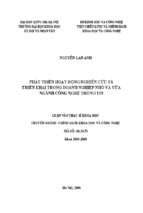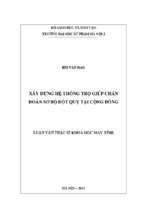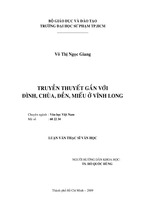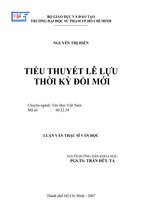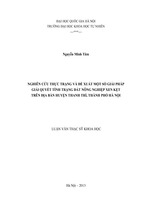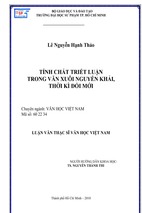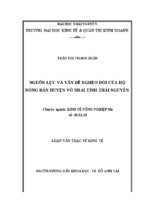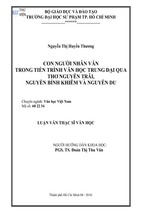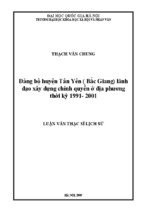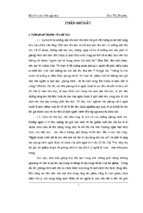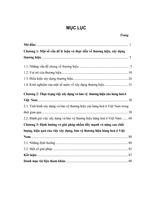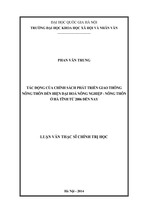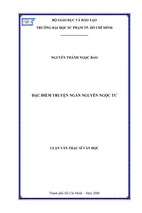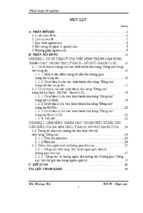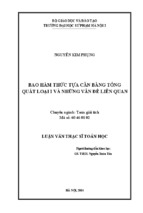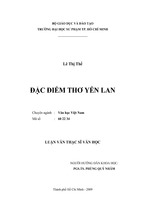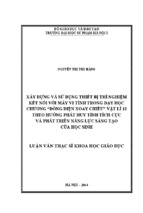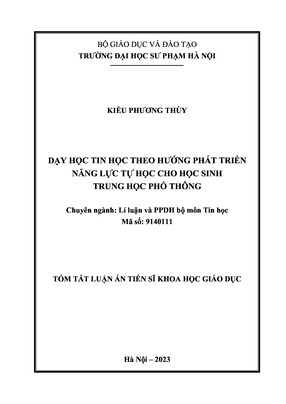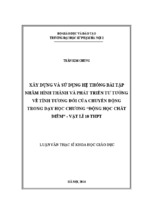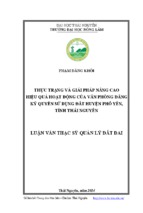VIETNAM NATIONAL UNIVERSITY – HO CHI MINH CITY
UNIVERSITY OF SOCIAL SCIENCES AND HUMANITIES
*********
VOCABULARY INSTRUCTION IN READING
COMPREHENSION FOR STUDENTS IN GRADE 11
AT TRUONG DINH HIGH SCHOOL
IN TIEN GIANG PROVINCE
A THESIS SUBMITTED IN PARTIAL FULFILLMENT OF
THE REQUIREMENTS FOR THE DEGREE OF MASTER OF TESOL
Submitted by PHAN ĐỖ NGỌC DIỆP
Supervisor
NGUYỄN THÁI ÂN, Ph.D.
HO CHI MINH CITY, 2011
i
CERTIFICATE OF ORIGINALITY
I certify my authorship of the thesis submitted today entitled:
VOCABULARY INSTRUCTION IN READING COMPREHENSION
FOR STUDENTS IN GRADE 11
AT TRUONG DINH HIGHSCHOOL
IN TIEN GIANG PROVINCE.
in terms of the statement of Requirements for Theses in Master’s Programs issued
by the Higher Degree Committee.
Ho Chi Minh City, November 24 th, 2011
PHAN ĐỖ NGỌC DIỆP
ii
RETENTION AND USE OF THE THESIS
I hereby state that I, PHAN ĐỖ NGỌC DIỆP, being the candidate for the
degree of Master of TESOL, accept the requirement of the university relating to the
retention and use of Master’s Thesis deposited in the library.
In terms of these conditions, I agree that the original of my thesis deposited
in the Library should be accessible for purposes of study and research, in
accordance with the normal conditions established by the Library for the care, loan
or reproduction of thesis.
Ho Chi Minh City, November 24 th, 2011
PHAN ĐỖ NGỌC DIỆP
iii
ACKNOWLEDGEMENTS
I would like to express my deepest gratitude to my thesis supervisor, Dr.
Nguyễn Thái Ân, who did provide me with insightful discussions, constructive
criticisms, valuable comments, and continuing support in the preparation and
completion of this thesis.
I am greatly in debt to all the lecturers of the TESOL graduate program at
the University of Social Sciences and Humanities for their helpful instruction
during the course from the year 2006 to 2009.
Finally, I would like to send my deepest gratitude to my family and my
friends who cared, encouraged and supported me during the time of completing the
thesis.
iv
ABSTRACT
Vocabulary knowledge has long been a major determinant influencing
ESL/EFL reading comprehension (Laufer, 1997). Reading comprehension
efficiently helps readers to improve their vocabulary. The more they would read
extensively the more ideas and words would be generated, which ultimately helps
in the development of vocabulary of the target language. Vocabulary acquisition is
one of the most challenging obstacles language learners must overcome.
The main objective of the study was to investigate the reality of vocabulary
instruction in reading comprehension for students in grade 11 at Truong Dinh high
school to find out what difficulties teachers and students face when dealing with
vocabulary instruction in reading comprehension and in what way vocabulary can
assist students in reading comprehension.
Sample of the study constituted of 2 classes if eleven graders and 10
teachers at this school. This study evaluates the vocabulary teaching component of
an English teaching program for students at high school. It first describes the
course and the issues which prompted the study.
Then it examines previous
research in vocabulary learning and applies some of the key findings to the
development of a research project. This project has two elements: questionnaires
related to vocabulary instruction in reading comprehension and classroom
observation to find out the reality of vocabulary instruction in reading
comprehension.
Data analysis of the questionnaire shows reality and problems of vocabulary
instruction in reading comprehension. Students know the importance of vocabulary
knowledge in comprehension but they do not know how to effectively deal with
new words in a reading text. Students should be actively involved in exploring
word meaning and learn how to figure out meaning with unknown words in reading
comprehension.
v
Findings from questionnaire and classroom observation reveal that teachers’
vocabulary instruction sometimes falls back to the “old” procedure of teaching
vocabulary: reading aloud, translating. In addition, teachers seem to lack
information about students’ real ability in reading. For this reason, teachers’
teaching methods do not meet the need of the students. Therefore, teacher should
take into consideration the actual desire of students in learning as well as the
problems students may encounter in reading comprehension. Students should be
well aware of the strategies to deal with unknown words in
a reading text. When students are taught how to get through with the reading text
more effectively, they will feel more confident in reading comprehension, which
also builds a bridge to success in learning English. “Guessing in context” and
“word parts” are useful techniques help to determine meaning of words in reading
comprehension.
vi
LIST OF ABBREVIATIONS
EFL: English as a foreign language
FL: Foreign Language
L1: first language
L2: second language
NRP: National Reading Panel
TDHS: Truong Dinh High School
vii
TABLE OF CONTENTS
Certificate of originality
i
Retention and use of the thesis
ii
Acknowledgements
iii
Abstract
iv
List of abbreviations
vi
Table of contents
vii
List of figures
xii
List of tables
xiii
CHAPTER 1: INTRODUCTION
1
1.1.
Background to the study
1
1.2.
Rationale of the study
3
1.3.
Problem statement
4
1.4.
Significance to the study
5
1.5.
Aims of the study
7
1.6.
Limitations
8
1.7. Study setting
8
1.7.1. The school
8
1.7.2. Syllabus
9
1.7.2.1. Aims and objectives of the syllabus
9
1.7.2.2. The content of the syllabus
9
1.7.2.3. The construction of the textbooks
9
1.7.2.4. Time allocation
10
1.7.2.5. Methods being used in teaching English at high schools
11
1.7.2.6. Students’ profile
11
1.8. Organization of the study
12
CHAPTER 2: LITERATURE REVIEW
13
2.1. Overview of the place of vocabulary in foreign language teaching
13
2.2. Teaching vocabulary in reading comprehension
15
viii
2.3. Correlation between vocabulary and reading comprehension
16
2.4. Need for vocabulary instruction
19
2.5. Perspectives on vocabulary instruction
20
2.5.1 Definition of vocabulary
20
2.5.2. Vocabulary learning process
21
2.5.3 What information is necessary to ‘know’ a word?
23
2.5.4. How should vocabulary be learned?
25
2.5.5. What makes a good vocabulary learner?
27
2.6. Principles of teaching and learning vocabulary
29
2.6.1. Vocabulary Knowledge
29
2.6.2. Principles of Vocabulary Instruction
32
2.6.3. Types of Vocabulary Instruction
34
2.7. Guessing meaning of unknown words
36
2.7.1. Guessing meaning of unknown words through context
38
2.7.2. Using word parts: prefixes, suffixes and roots
42
CHAPTER 3: METHODOLOGY
45
3.1.
45
Research questions
3.2. Research design
46
3.2.1. Subjects
46
3.3.2. Instruments
47
3.3.2.1. Questionnaires
48
3.3.2.1.1. Questionnaire for students
48
3.3.2.1.2. Questionnaire for teachers
50
3.3.2.2.
Classroom observation
50
Data collection procedure
52
3.4.
3.4.1. Data collection procedure of questionnaires
52
3.4.2. Data collection procedure of classroom observations
52
3.5.
53
Conclusion
CHAPTER 4: DATA ANALYSIS AND FINDINGS
54
ix
4.1. Analysis of students’ responses
54
4.1.1. Question 1: Factors can help students to comprehend the text better
54
4.1.2. Question 2: The most important thing teachers should do to help
students get success in vocabulary instruction
55
4.1.3. Question 3: The importance of context in guessing meaning of
new words
56
4.1.4. Question 4. What students do when they find a new word
57
4.1.5. Question 5: Difficulties students encounter when reading
a text in the textbook
58
4.1.6. Question 6: The ways students apply to learn vocabulary
60
4.1.7. Question 7: What teachers should do to help students acquire
good ability of guessing meaning of unknown words
61
4.1.8. Question 8: Techniques students learn to guess meaning
of unknown words
62
4.1.9. Question 9: Technique students apply when trying to guess
meaning of unknown words in a reading text
64
4.1.10. Question 10: Students’ opinions on vocabulary instruction
65
4. 1.11. Question 11: Which role of context should be taught to students
67
4.2. Analysis of teachers’ responses
68
4.2.1. Question 1: Factors can help students to comprehend the text better
68
4.2.2. Question 2: The most important thing teachers should do to help
students get success in vocabulary instruction
69
4.2.3. Question 3: The importance of context in guessing meaning of
new words
70
4.2.4. Question 4. What students do when they find a new word
71
4.2.5. Question 5: Difficulties students encounter when reading
a text in the textbook
72
4.2.6. Question 6: Ways students apply to learn vocabulary effectively
73
4.2.7. Question 7: Techniques students should employ to guess
x
meaning of unknown words
74
4.2.8 Question 8: How often teachers use different techniques
in vocabulary instruction
75
4.2.9. Question 9. How often teachers translate the text into Vietnamese
to students
77
4.2.10. Question 10: The most effective strategies in presenting new words 78
4.2.11. Question 11: Which role of context should be taught to students
79
4.3. Analysis of classroom observations
80
4.3.1. Analysis of techniques teachers applied in vocabulary
instruction in reading comprehension
80
4.3.2. Analysis of the number of words presented in each lesson
82
4.3.3. Analysis of the selection of words presented in each lesson.
83
CHAPTER 5: SUGGESTIONS AND CONCLUSIONS
85
5.1. Suggestions
85
5.1.1. Suggestions to teachers
87
5.1.1.1. Finding suitable ways to teach vocabulary to students
87
5.1.1.2. Helping students become confident with new words and new texts 88
5.1.1.3. Continuing to acquire knowledge of linguistics, developmental
stages of and instructional practices that enhance word knowledge
among students
89
5.2.2. Suggestions to students
90
5.2.2.1. Changing the habit of learning
91
5.2.2.2. Dealing with unknown words when reading
92
5.3. Conclusion
94
BIBLIOGRAPHY
96
APPENDIX 1: QUESTIONNAIRE (for teachers)
104
APPENDIX 2: QUESTIONNAIRE (for students)
107
APPENDIX 3: PHIẾU KHẢO SÁT (dành cho học sinh)
110
APPENDIX 4: CLASSROOM OBSERVATION SHEET
114
xi
APPENDIX 5: CLASSROOM OBSERVATION REPORT CLASS 1
115
xii
LIST OF FIGURES
Figure 1: Vocabulary as an Important Component of Reading
17
Figure 2: Limited vocabulary skills can limit vocabulary development
18
xiii
LIST OF TABLES
Table 1. Subjects specification
46
Table 2.The objectives of the questionnaire for students
49
Table 3.The objectives of the questionnaire for teachers
50
Table 4. The time framework of the four classes
52
Table 5. Factors can help students to comprehend the text better
54
Table 6. The most important thing teachers should do to help
students get success in vocabulary instruction
56
Table 7. The importance is of context in guessing meaning of
new words
57
Table 8. What students do when they find a new word
58
Table 9. Difficulties students encounter when reading a text in
the textbook
59
Table 10. The ways students apply to learn vocabulary effectively
60
Table 11. What teachers should teacher should do to help students
acquire good ability of guessing meaning of unknown words
61
Table 12. Techniques students learn to guess meaning of unknown
words
64
Table 13. Techniques students apply when trying to guess meaning
of unknown words in a reading text
64
Table 14. Students’ opinions on vocabulary instruction conducted
by teachers
66
Table 15. Which role of context should be taught to students
67
Table16. Factors can help students to comprehend the text better
68
Table 17. The most important thing teachers should do to help
students get success in vocabulary instruction
70
Table18. The importance of context in guessing meaning of new words
70
Table 19. What students do when they find a new word
71
Table 20. Difficulties students encounter when reading a text in
xiv
the textbook
72
Table 21. The ways students apply to learn vocabulary effectively
73
Table 22. Techniques students learn to guess meaning of unknown
words
74
Table 23. Vocabulary instruction conducted by teachers in the
classroom
76
Table 24.How often teachers translate the text into Vietnamese to
students
77
Table 25. The most effective strategies in presenting new words
78
Table 26. Which role of context should be taught to students
79
Table 27. Frequency of techniques applied in vocabulary instruction
in reading comprehension
80
Table 28. The number of words presented in each lesson
82
1
CHAPTER 1
INTRODUCTION
1.7.
Background to the study
According to Baumamn and Kameenui (1991) words are the tools we use to
access our background knowledge, express ideas, and learn about new concepts.
Students’ word knowledge is linked closely to academic success. Success in
reading comprehension is usually seen as fundamental to the academic success of
foreign language learners. Second language proficiency often assumes vocabulary
and grammar as knowledge and reading as the ability to understand the text (Koda,
2005). Research consistently reveals that vocabulary knowledge heavily relates to
reading comprehension more so than other factors such as grammar knowledge
(Koda, 1989; Qian, 1999). Laufer (1997:20) has written, “No text comprehension is
possible, either in one native language or in a foreign language, without
understanding the text’s vocabulary. Hence, without understanding the meaning of
words, second language readers may have a hard time developing comprehension.
Consequently, vocabulary seems to be an important factor in reading
comprehension (Richard & Rodgers, 2001). The stronger the vocabulary
knowledge the EFL student has, the better reading comprehension the reader will
achieve (Mecartty, 2000). Laufer (1997) indicates that it is not possible to achieve
comprehension, either for native speakers or second language learners, without
understanding the vocabulary in the text. Laufer further claims that second
language reading comprehension is affected by vocabulary alone. The breath of
vocabulary knowledge is usually presented as vocabulary size, which refers to the
numbers of the words that second language learners know, rather than emphasizing
on how well learners know given words. Anderson, R.C & Freebody, P.(1981) also
2
find that word knowledge is crucial to reading comprehension, and determines how
well students will be able to comprehend the texts they read in the upper
elementary grades, in middle and high school, and in college. Although it is true
that comprehension is far more than recognizing words and remembering their
meanings, it is also true that if a reader does not know the meanings of a sufficient
proportion of the words in the text, comprehension is impossible.
Laufer and Sim (1985) show that FL learners seem to rely more on
vocabulary meaning than on knowledge of the subject or syntax. This means that a
certain size of vocabulary has to be known to the learners before they can approach
a text comfortably. As such, vocabulary learning and teaching must be an important
part in the L2 classroom have examined the use of direct teaching including
teaching vocabulary learning strategies as one of the means of promoting the
development of L2 vocabulary knowledge. As a matter of fact, it has been
suggested that one way to increase the speed of learning vocabulary of a second or
a foreign language or a foreign language is to teach learners how to learn
vocabulary more efficiently and effectively. Graves (2000) states that if students
want to be successful in understanding unfamiliar vocabulary in their reading, they
need to learn about words not simply acquire new words. Instruction that supports
independent vocabulary learning strategies shows students how to determine the
meaning of unfamiliar vocabularies. On the whole, independent vocabulary
learning strategies are procedures that teachers can model and teach explicitly to
students to show them how to determine the meaning of unknown vocabularies.
Additionally, teaching vocabulary learning strategies directly can help students
become better independent vocabulary learners (Baumann, Edwards & Kameenui,
2003; Blachowicz & Fisher, 2000; NRP, 2000). Therefore, vocabulary instruction
plays an important role in reading comprehension. A study on how to help students
overcome trouble in dealing with unknown words in a reading passage should be
carried down to find solutions to these problems.
3
1.8.
Rationale of the study
Students at Truong Dinh High school (TDHS) do have difficulties learning
English especially when reading. They often confide that not only vocabulary but
also reading is the thing that makes them frustrated most when learning English.
However, they forget the words they learn very quickly for the reason that
students do not know effective way to master vocabulary. High school students
study vocabulary by reading the words aloud and writing them down on a piece
of paper again and again. They often learn the words in isolation not in context
and they pay much attention to Vietnamese meaning of the words rather than how
to use the words in specific context. In addition to this, vocabulary instruction
being presented at high school is rather old. Teachers pay much attention to word
meaning rather than how the word is used in different context or how to figure out
the meaning of a new word when reading (this can be seen in frequency of
techniques applied in vocabulary instruction in reading comprehension). Teachers
tend to give list of words and Vietnamese equivalents at the beginning of a
reading period. Teachers just focus on how to help students understand the
content of the reading text. Therefore, they sometimes translate the text into
Vietnamese, which made students passive and dependent on teachers. As a result
of this, the knowledge students get is not systematical, but somewhat mechanical.
This makes students bored in the learning process. Teachers should motivate
students in learning by providing them with suitable learning strategies when
dealing with a reading text, e.g. teaching students to deal with unknown words.
For this reason, it is necessary to carry out a study to find out what difficulties
students and teachers face when dealing with vocabulary in reading
comprehension and how vocabulary instruction can assist students to perform
better in reading comprehension.
4
1.9.
Problem statement
Reading comprehension is one of the four language skills which require the
teachers and learners to invest more time and energy to develop. Difficulties are
often experienced by teachers when teaching English as a foreign language when
reading is involved. Reading materials may be too difficult in terms of level, they
may lack excitement, or some may be nothing more than texts on pages.
Reading is such an important skill that learners need to spend time practicing
it. Reading can provide “comprehensive input” as it leads to language acquisition.
It can also enhance learners’ language competence. In addition, it increases the
students’ exposure to the language as well as knowledge of vocabulary. Besides,
reading can lead to improvement in writing. At the same time reading can
consolidate previously learned language.
When learning a foreign language, reading comprehension is important as it
contains elements that link the other three skills: listening, speaking, and writing. In
order to understand foreign language, learners should be well-trained in classes.
However, there are factors leading to passive learning. First, learners think reading
is boring and time consuming. Second, they treat reading as a simple task of
understanding all the words in the passage, so they ignore other functions of
reading. Third, they acquire reading passively from textbook, not actively in
combination with other skills. At last, they hesitate to apply what they have learnt
into practice. For the above factors, learners often have difficulty in learning
reading comprehension. So do my students at high school.
In fact, students have difficulty understanding the reading passage because
they lack the ability to deal with unknown words in the text. Students tend to
translate words by words into Vietnamese before doing the reading tasks. It is no
good learning English like that, particularly in reading comprehension. In reality,
people read because they want to obtain the necessary information. Therefore, in
some cases, people just pay much attention to the main ideas or gist. For example,
5
when reading an advertisement in a paper or a notice on board, they just read the
main point, not read all the words.
As a teacher of English at high school and with the observation on the
students’ learning process and their test performance’s scores, the researcher sees
that students know very little of how to deal with unfamiliar words in a reading
passage and they have limited amount of vocabulary. For this reason, they are often
confused when doing reading comprehension test. They also feel bored when
learning reading and pay less attention to reading than to other language skills. In
order to help them get over their problems in reading comprehension, the
researcher spends time studying vocabulary instruction in reading comprehension
to find out the major problems related to this aspect and suggest solutions to these
problems.
Some researches about aspects of reading have been done. They do
contribute a lot to the effectiveness of teaching reading concerning different aspects
of learners. But more aspects of reading still wait ahead for further research.
Therefore, the researcher continues the work of former researchers.
1.4. Significance to the study
Vocabulary, which consists of the knowledge of meaning as the main
component of a language, should be taught together with reading, structure and
conversation. Vocabulary is also a means of communication. One can not always
communicate without using words conveys their thoughts, especially in written
form. So vocabulary should be part of a reading course because one needs the
mastery of vocabulary to comprehend the reading passage.
In learning English people can not only master one skill. Language is the
integration of the four skills: speaking, listening, reading, and writing. Language
- Xem thêm -


